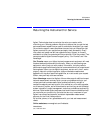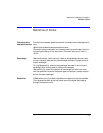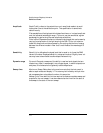
7-4
Specifications and Regulatory Information
Definition of Terms
Amplitude Scale Fidelity refers to the potential errors in amplitude readout at ampli-
tudes other than at the calibration point. This specification is sometimes
called linearity.
Flatness defines a floating band which describes the error in signal amplitude
over the indicated wavelength range. (This error may be removed at a given
wavelength by performing the user amplitude calibration.)
Polarization Dependence refers to the amplitude change that can be seen by
varying the polarization of the light entering the OSA. This is not to be con-
fused with amplitude variations caused by the varying distribution of energy
between the different modes in fiber that is multimode at the wavelength of
interest.
Sensitivity Sensitivity is defined as the signal level that is equal to six times the RMS
value of the noise. Displayed sensitivity values are nominal. Slightly lower val-
ues may have to be entered to achieve specified sensitivity.
Dynamic range Dynamic Range is a measure of the ability to see low-level signals that are
located very close (in wavelength) to a stronger signal. In electrical spectrum
analyzers, this characteristic is generally called shape factor.
Sweep time Maximum Sweep Rate refers to the maximum rate that the instrument is
able to acquire data and display it. This rate may be limited by multiple inter-
nal processes when using default number of trace points.
Sweep Cycle Time refers to the time required to make a complete sweep and
prepare for the next sweep. It can be measured as the time from the start of
one sweep to the start of the next sweep.


















